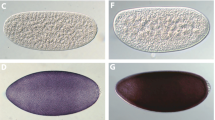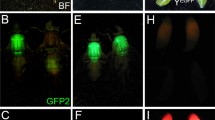Abstract
The Mexican fruit fly, Anastrepha ludens, is a highly significant agricultural pest species that has been genetically transformed with a piggyBac-based transposon vector system using independent vector and transposase helper plasmids. Minimum estimated germ-line transformation frequencies were approximately 13–21% per fertile G0 individual, similar to previously reported frequencies using single vector-helper plasmids. Two vector constructs were tested with potential importance to transgenic strain development for mexfly biological control. The first allows post-integration stabilization of a transposon-vector by deletion of a terminal sequence necessary for mobilization. The complete pB[L1-EGFP-L2-DsRed-R1] vector was integrated into the Chiapas wild type strain with subsequent deletion of the L2-DsRed-R1 sub-vector carrying the piggyBac 3′ terminal sequence. Quality control tests for three of the stabilization vector lines (previous to stabilization) assessed viability at all life stages, fertility, adult flight ability, and adult male sexual competitiveness. All three transgenic lines were less fit compared to the wild strain by approximately 5–10% in most tests, however, there was no significant difference in sexual competitiveness which is the major prerequisite for optimal strain release. The second vector, pB[XL-EGFP, Asß2-tub-DsRed.T3], has the DsRed.T3 fluorescent protein reporter gene regulated by the A. suspensa Asß2-tubulin promoter, that resulted in testis and sperm-specific DsRed fluorescence in transgenic male mexflies. Fluorescent sperm bundles were unambiguously observed in the spermathecae of non-transgenic females mated to transgenic males. One transgenic line apparently had a male-specific Y-chromosome insertion, having potential use for sexing by fluorescent-embryo sorting. All transgenic lines expressed easily detectable and stable fluorescence in adults allowing their identification after trapping in the field.





Similar content being viewed by others
References
Allen ML, Berkebile DR, Skoda SR (2004) Postlarval fitness of transgenic strains of Cochliomyia hominivorax (Diptera: Calliphoridae). J Econ Entomol 97:1181–1185
Alphey L (2002) Re-engineering the sterile insect technique. Insect Biochem Mol Biol 32:1243–1247
Bevis BJ, Glick BS (2002) Rapidly maturing variants of the Discosoma red fluorescent protein (DsRed). Nat Biotechnol 20:83–87
Catteruccia F, Godfray HC, Crisanti A (2003) Impact of genetic manipulation on the fitness of Anopheles stephensi mosquitoes. Science 299:1225–1227
Condon KC, Condon GC, Dafa’alla TH, Fu G, Phillips CE, Jin L, Gong P, Alphey L (2007a) Genetic sexing through the use of Y-linked transgenes. Insect Biochem Mol Biol 37:1168–1176
Condon KC, Condon GC, Dafa’alla TH, Forrester OT, Phillips CE, Scaife S, Alphey L (2007b) Germ-line transformation of the Mexican fruit fly. Insect Mol Biol 16:573–580
Dafa’alla TH, Condon GC, Condon KC, Phillips CE, Morrison NI, Jin L, Epton MJ, Fu G, Alphey L (2006) Transposon-free insertions for insect genetic engineering. Nat Biotechnol 24:820–821
FAO/IAEA/USDA (2003) Manual for Product Quality Control and Shipping Procedures for Sterile Mass-Reared Tephritid Fruit Flies Version 5.0. [IAEA] (International Atomic Energy Agency)
Gutiérrez-Ruelas JM, Santiago-Martínez G (2008) Situación actual de la campaña nacional contra moscas de la fruta en México. In: Montoya-Gerardo PJ, Díaz-Fleischer F, Breceda S (eds) Proceedings: 7th meeting of the working group on fruit flies of the Western Hemisphere. Mazatlan, Sinaloa, México, pp 11–13
Handler AM (2002) Prospects for using genetic transformation for improved SIT and new—biocontrol methods. Genetica 116:137–149
Handler AM (2004) Understanding and improving transgene stability and expression in insects for SIT and conditional lethal release programs. Insect Biochem Mol Biol 34:121–130
Handler AM, Harrell RA (1999) Germline transformation of Drosophila melanogaster with the piggyBac transposon vector. Insect Mol Biol 8:449–458
Handler AM, Harrell RA (2001a) Polyubiquitin-regulated DsRed marker for transgenic insects. Biotechniques 31:820–828
Handler AM, Harrell RA (2001b) Transformation of the Caribbean fruit fly, Anastrepha suspensa, with a piggyBac transposon vector marked with polyubiquitin-regulated GFP. Insect Biochem Mol Biol 31:199–205
Handler AM, McCombs SD, Fraser MJ, Saul SH (1998) The lepidopteran transposon vector, piggyBac, mediates germ-line transformation in the Mediterranean fruit fly. Proc Natl Acad Sci USA 95:7520–7525
Handler AM, Zimowska GJ, Horn C (2004) Post-integration stabilization of a transposon vector by terminal sequence deletion in Drosophila melanogaster. Nat Biotechnol 22:1150–1154
Horn C, Handler AM (2005) Site-specific genomic targeting in Drosophila. Proc Natl Acad Sci USA 102:12483–12488
Irvin N, Hoddle MS, O’Brochta DA, Carey B, Atkinson PW (2004) Assessing fitness costs for transgenic Aedes aegypti expressing the GFP marker and transposase genes. Proc Natl Acad Sci USA 101:891–896
Knipling EF (1955) Possibilities of insect control or eradication through the use of sexually sterile males. J Econ Entomol 48:459–462
McCombs SD, Lee SG, Saul SH (1993) Translocation-based genetic sexing system to enhance the sterile insect technique against the melon fly (Diptera: Tephritidae). Ann Entomol Soc Am 86:651–654
McInnis DO, Lance DR, Jackson CG (1996) Behavioral resistance to the sterile insect technique by Mediterranean fruit fly (Diptera: Tephritidae) in Hawaii. Ann Entomol Soc Am 89:739–744
Orozco-Dávila D, Hernández R, Meza S, Domínguez J (2007) Sexual competitiveness and compatibility between mass-reared sterile flies and wild populations of Anastrepha ludens (Diptera: Tephritidae) from different regions in Mexico. Florida Entomol 90:19–26
Robinson AS, Franz G, Fisher K (1999) Genetic sexing strains in the medfly, Ceratitis capitata: development, mass rearing and field application. Trends Entomol 2:81–104
Robinson AS, Franz G, Atkinson PW (2004) Insect transgenesis and its potential role in agriculture and human health. Insect Biochem Mol Biol 34:113–120
Rull Gabayet JA, Reyes Flores J, Enkerlin W (1996) The Mexican national fruit fly eradication campaign: largest fruit fly industrial complex in the world. In: McPheron BA, Steck GJ (eds) Fruit fly pests: a world assessment of their biology and management. St. Lucie Press, Delray Beach, pp 561–563
Schetelig MF, Scolari F, Handler AM, Kittelmann S, Gasperi G, Wimmer EA (2009) Site-specific recombination for the modification of transgenic strains of the Mediterranean fruit fly Ceratitis capitata. Proc Natl Acad Sci USA 106:18171–18176
Zar JH (1999) Biostatistical analysis, 4th edn. Prentice Hall, Englewood Cliffs
Zepeda-Cisneros CS, Meza JS, Gálvez S, Ibañez J, Robinson AS (2009) Inheritance and linkage studies on eye color mutations in Anastrepha ludens (Diptera: Tephritidae). Ann Entomol Soc Am 103:96–99
Zimowska GJ, Nirmala X, Handler AM (2009) The beta2-tubulin gene from three tephritid fruit fly species and use of its promoter for sperm marking. Insect Biochem Mol Biol 39:508–515
Acknowledgments
Grateful appreciation is extended to the International Atomic Energy Agency (IAEA) for funding though the Technical Co-operation Project MEX/5/027. Additional support was provided by the USDA-NIFA-Agriculture and Food Research Initiative (AMH) and the Campaña Moscas de la Fruta (Mexican Fruit Fly Campaign) DGSV-SAGARPA.
Author information
Authors and Affiliations
Corresponding author
Electronic supplementary material
Below is the link to the electronic supplementary material.
10709_2010_9484_MOESM2_ESM.doc
Supplementary Figure 1 PCR product sequences for the 5’ and 3’ insertion sites for the pB[L1-EGFP-L2-DsRed-R1] vector in genomic DNA from the 11M3 green/red strain and the L1-EGFP sequence stabilized by post-integration deletion of the L2-DsRed-R1 sub-vector in the 11M3 green strain. PCR products were extracted from indicated lanes (see Fig. 2 and Table 3) and sequenced from subclones using either M13 or internal primers. (A) shows the same sequence for the 5’ insertion site for both the 11M3 green/red (lane 1) and green (lane 5) strains using the 534F and 122R primers; (B) shows the 3’ insertion site sequence for the 11M3 green/red strain using primers 144F and 515R; and (C) shows the 3’ insertion site sequence for the 11M3 green strain (lane 9) using primers 387F and 515R after deletion of the L2-DsRed-R1 sub-vector. Primers sites are indicated by arrows below or above, the TTAA duplicated insertion site is double-underlined, piggyBac terminal sequences are in bold (A, B), and EGFP/SV40 sequences are single-underlined (C)
Rights and permissions
About this article
Cite this article
Meza, J.S., Nirmala, X., Zimowska, G.J. et al. Development of transgenic strains for the biological control of the Mexican fruit fly, Anastrepha ludens . Genetica 139, 53–62 (2011). https://doi.org/10.1007/s10709-010-9484-6
Received:
Accepted:
Published:
Issue Date:
DOI: https://doi.org/10.1007/s10709-010-9484-6




